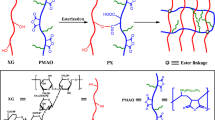Abstract—
Xanthan gum is widely used as a stabilizing, emulsifying, thickening agent in pharmacology, medicine, food, oil, paint and varnish, textile, perfumery, mining industry and agriculture. For food purposes, potassium, sodium or calcium salts of xanthan are used formed due to carboxyl groups of glucuronic acid and the pyruvate group. At present, xanthan gum is not produced on an industrial scale in Russia. There are numerous attempts to create the production facilities in different regions of the country. In this work, hydrophobized acetylated xanthan gum derivatives with various degrees of substitution were synthesized. A comparison of physicochemical and colloid-chemical properties of the initial and modified gum was carried out by viscometry, tensiometry, and IR spectroscopy methods. A point of zero charge of xanthan gum was determined. A change in the conformation of macromolecules depending on pH of water solution and preliminary dehydration was demonstrated. Separation temperatures of the initial and modified forms of xanthan gum were determined. The critical concentration of micelle formation of the modified gum is 0.2%. At this concentration, the surface activity of gum is 6.1 and 7.9 mJ m/kg when substituting two and five hydroxo groups, respectively. The possibility of using the modified xanthan gum as a binder for the production of fuel pellets with increased performance properties and calorific value was demonstrated.




Similar content being viewed by others
REFERENCES
Polysaccharides: Structural Diversity and Functional Versatility, Dumitriu, S., Ed., New York: Marcel Dekker, 2005. https://doi.org/10.1021/ja0410486
Donchenko, L.V., Sokol, N.V., and Krasnoselova, E.A., Pishchevaya khimiya. Gidrokolloidy (Food Chemistry. Hydrocolloids), Moscow, 2018.
Nordin, N.Z., Rashidi, A.R., Dailin, D.J., Abd Malek, R., Wan Azelee, N.I., Abd Manas, N.H., Selvamani, Sh., Abg Zaidel, D.N., Abd Alsaheb, R.A., Sukmawati, D., and El Enshasy, H., Xanthan biopolymer in pharmaceutical and cosmeceutical applications, Biosci. Res., 2020, vol. 17, pp. 205–220.
Lopes, B.D.M., Lessa, V.L., Silva, B.M., and la Cerda, L.G., M Xanthan gum: Properties, production conditions, quality and economic perspective, J. Food Nutrit. Res., 2015, vol. 54, pp. 185–194.
Saha, D. and Bhattacharya, S., Hydrocolloids as thickening and gelling agents in food: A critical review, J. Food Sci. Technol., 2010, vol. 47, pp. 587–597. https://doi.org/10.1007/s13197-010-0162-6
Vasil’eva, A.P., Borodina, A.M., Novikova, A.A., and Osovskaya, I.I., Modification of the surface properties of xanthan gum in the context of its practical applications, in Tez. dokl. XXI Mendeleevskogo s’ezda po obshchei i prikladnoi khimii (Proceedings of the 21st Mendeleev Congress on General and Applied Chemistry), 2019, vol. 2, p. 115.
Borodina, A.M. and Vasil’eva, A.P., Influence of medium pH on viscosity and surface activity of modified forms of guar gum material for capsule shells, in Tez. dokl. XXV Karginskie chteniya: Vserossiiskaya molodezhnaya konferentsiya Fizika, khimiya i novye tekhnologii (Proceedings of the 25th Kargin Readings: All-Russia Youth Conference on Physics, Chemistry and New Technologies), 2019, p. 101.
Osovskaya, I.I., Vasil’eva, A.P., and Kurzin, A.V., IR spectra of modified guar gum, in Materialy VIII Vserossiiskoi konferentsii s mezhdunarodnym uchastiem Novye dostizheniya v khimii i khimicheskoi tekhnologii rastitel’nogo syr’ya (Proceedings of the 8th All-Russia Conference on New Advances in Chemistry and Chemical Technology of Plant Raw Materials), Barnaul, 2020, pp. 289–290.
Akhmedov, O.R. and Shomurotov, Sh.A., Biologically active compounds based on modified xanthan gum, Khim. Rastit. Syr’ya, 2017, no. 3, pp. 227–231. https://doi.org/10.14258/jcprm.2017031729
Vernikovskii, V.V. and Tret’yakova, E.V., Excipients in oral suspensions, Razrab. Registr. Lek. Sredstv, 2017, no. 2, pp. 116–123.
Muljana, H., Kleopas Sugih, A., Prima Kristijarti, A., Karlus, R., Kurnia, R., Evan, C., and Picchioni, F., Acetylation of xanthan gum in densified carbon dioxide (CO2), Mater. Today: Proc., 2018, vol. 5, pp. 21551–21558. https://doi.org/10.1016/j.matpr.2018.07.003
Liyas’kina, E.V., Revin, V.V., Groshev, M.V., and Liyas’kin, Yu.K., Biotekhnologiya bakterial’nykh ekzopolisakharidov (Biotechnology of Bacterial Exopolysaccharides), Saransk, 2010.
Patel, J., Maji, B., Hari Narayana Moorthya, N.S., and Sabyasachi Maiti, Xanthan gum derivatives: Review of synthesis, properties and diverse applications, RSC Adv., 2020, vol. 10, pp. 27103–27136. https://doi.org/10.1039/d0ra04366d
Rinaudo, M., Milas, M., Lambert, F., and Vincendon, M., Proton and carbon-13 NMR investigation of xanthan gum, Macromolecules, 1983, vol. 16, no. 5, pp. 816–819. https://doi.org/10.1021/ma00239a018
O'Connor, R.T., du Prè, E., and Mitcham, D., Application of infraredabsorption spectroscopy to investigations of cotton and modified cottons. Part I. Physical and cristalline modification and oxidation, Text. Res. J., 1958, vol. 28, no. 5, pp. 382–392. https://doi.org/10.1177/004051755802800503
Teotia, A.K., Sami, H., and Kumar, A., Thermo-responsive polymers, in Switchable and Responsive Surfaces and Materials for Biomedical Applications, Amsterdam: Elsevier, 2015, pp. 3–43. https://doi.org/10.1016/B978-0-85709-713-2.00001-8
Osovskaya, I.I., Demyantseva, E.Yu., Borodin, A.M., and Vasilyeva, A.P., Composition for obtaining solid wood fuel, RF Patent no. 2707072, Byull. Izobret., 2019, no. 33.
Alekseev, A., Oil and cosmetics, Tekhnol. Bud., Klyuch. Tekhnol. Proekty Gazprom Nefti, 2019, no. 166. https://www.gazprom-neft.ru/press-center/sibneft-online/archive/2019-november/3914082/.
The 5-100 project opens up new perspectives for the development of biology, Upravl. Strateg. Kommun. TyumGU, 2019. https://news.utmn.ru/opinions/299261/.
Danilova, Yu., Xanthan production project to be adjusted through technology transfer, Biznes, Ekon., Vlast’, 2018. https://infopro54.ru/news/proekt-po-proizvodstvu-ksantana-podkorrektiruyut-za-schet-transfera-texnologij.
Author information
Authors and Affiliations
Corresponding author
Ethics declarations
The authors declare that they have no conflicts of interest. This article does not contain any studies involving human participants or animals performed by any of the authors.
Additional information
Translated by A. Barkhash
Rights and permissions
About this article
Cite this article
Osovskaya, I.I., Borodina, A.M., Kurzin, A.V. et al. Synthesis and Properties of Modified Xanthan Gum. Russ J Bioorg Chem 48, 1526–1533 (2022). https://doi.org/10.1134/S1068162022070226
Received:
Revised:
Accepted:
Published:
Issue Date:
DOI: https://doi.org/10.1134/S1068162022070226



